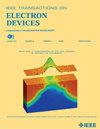Thermionic Electron Emission Capacity of the Ba₃ScGa₂O₇.₅ Impregnated Cathode
IF 2.9
2区 工程技术
Q2 ENGINEERING, ELECTRICAL & ELECTRONIC
引用次数: 0
Abstract
The high content of Ba and Sc in Ba3ScGa2O7.5 and its suitable melting point suggest that it is a candidate for thermionic emission in vacuum electron devices. To study its electron emission capacity, this compound was synthesized atBa₃ScGa₂O₇.₅ 浸渍阴极的热离子电子发射能力
Ba3ScGa2O7.5中Ba和Sc的高含量及其合适的熔点表明它是真空电子设备中热电子发射的候选材料。为了研究它的电子发射能力,我们在 1300~^{\circ }$ C 的温度下采用高温固相法合成了这种化合物,其化学计量摩尔比为 BaCO3:Sc2O3:Ga2O $_{{3}} =6$ :1:2。浸渍了这种材料的测试阴极具有很高的发射能力,在直流模式下,850~^{\circ }$ C 的全空间电荷电流密度为 10.2 A/cm2 。该化合物与钨粉的烧结混合物表明,阴极表面形成的 Ba3Sc2WO9 可降低功函数,从而提高发射性能。加上低温下的高发射电流密度,浸渍了 Ba3ScGa2O7.5 复合物的阴极具有优异的热离子阴极性能,在真空电子器件中的应用前景广阔。
本文章由计算机程序翻译,如有差异,请以英文原文为准。
求助全文
约1分钟内获得全文
求助全文
来源期刊

IEEE Transactions on Electron Devices
工程技术-工程:电子与电气
CiteScore
5.80
自引率
16.10%
发文量
937
审稿时长
3.8 months
期刊介绍:
IEEE Transactions on Electron Devices publishes original and significant contributions relating to the theory, modeling, design, performance and reliability of electron and ion integrated circuit devices and interconnects, involving insulators, metals, organic materials, micro-plasmas, semiconductors, quantum-effect structures, vacuum devices, and emerging materials with applications in bioelectronics, biomedical electronics, computation, communications, displays, microelectromechanics, imaging, micro-actuators, nanoelectronics, optoelectronics, photovoltaics, power ICs and micro-sensors. Tutorial and review papers on these subjects are also published and occasional special issues appear to present a collection of papers which treat particular areas in more depth and breadth.
 求助内容:
求助内容: 应助结果提醒方式:
应助结果提醒方式:


